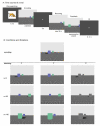Development of Landmark Use for Navigation in Children: Effects of Age, Sex, Working Memory and Landmark Type
- PMID: 35741661
- PMCID: PMC9221540
- DOI: 10.3390/brainsci12060776
Development of Landmark Use for Navigation in Children: Effects of Age, Sex, Working Memory and Landmark Type
Abstract
The use of landmarks for navigation develops throughout childhood. Here, we examined the developmental trajectory of egocentric and allocentric navigation based on landmark information in an on-screen virtual environment in 39 5-6-year-olds, 43 7-8-year-olds, and 41 9-10-year-olds. We assessed both categorical performance, indicating the notion of location changes based on the landmarks, as well as metrical performance relating to the precision of the representation of the environment. We investigated whether age, sex, spatial working memory, verbal working memory, and verbal production of left and right contributed to the development of navigation skills. In egocentric navigation, Categorical performance was already above chance at 5 years of age and was positively related to visuo-spatial working memory and the production of left/right, whereas metrical performance was only related to age. Allocentric navigation started to develop between 5 and 8 years of age and was related to sex, with boys outperforming girls. Both boys and girls seemed to rely more on directional landmark information as compared to positional landmark information. To our knowledge, this study is the first to give insight into the relative contribution of different cognitive abilities to navigation skills in school-aged children.
Keywords: development; individual differences; spatial cues; spatial navigation; virtual reality; working memory.
Conflict of interest statement
The authors declare no conflict of interest.
Figures



Similar articles
-
Landmark and route knowledge in children's spatial representation of a virtual environment.Front Psychol. 2015 Jan 23;5:1522. doi: 10.3389/fpsyg.2014.01522. eCollection 2014. Front Psychol. 2015. PMID: 25667573 Free PMC article.
-
The influence of age in women in visuo-spatial memory in reaching and navigation tasks with and without landmarks.Neurosci Lett. 2018 Sep 25;684:13-17. doi: 10.1016/j.neulet.2018.06.054. Epub 2018 Jun 30. Neurosci Lett. 2018. PMID: 29966753
-
Navigation strategies in patients with vestibular loss tested in a virtual reality T-maze.J Neurol. 2022 Aug;269(8):4333-4348. doi: 10.1007/s00415-022-11069-z. Epub 2022 Mar 20. J Neurol. 2022. PMID: 35306619
-
Egocentric and Allocentric Spatial Memory in Mild Cognitive Impairment with Real-World and Virtual Navigation Tasks: A Systematic Review.J Alzheimers Dis. 2021;79(1):95-116. doi: 10.3233/JAD-201017. J Alzheimers Dis. 2021. PMID: 33216034 Free PMC article.
-
A Critical Review of Spatial Abilities in Down and Williams Syndromes: Not All Space Is Created Equal.Front Psychiatry. 2021 May 28;12:669320. doi: 10.3389/fpsyt.2021.669320. eCollection 2021. Front Psychiatry. 2021. PMID: 34122185 Free PMC article. Review.
Cited by
-
Application of Virtual Reality in Spatial Memory.Brain Sci. 2023 Nov 23;13(12):1621. doi: 10.3390/brainsci13121621. Brain Sci. 2023. PMID: 38137069 Free PMC article.
-
Bilingual Spatial Cognition: Spatial Cue Use in Bilinguals and Monolinguals.Brain Sci. 2024 Jan 27;14(2):134. doi: 10.3390/brainsci14020134. Brain Sci. 2024. PMID: 38391709 Free PMC article.
-
Navigating space and the developing mind.Front Psychol. 2025 May 14;16:1521487. doi: 10.3389/fpsyg.2025.1521487. eCollection 2025. Front Psychol. 2025. PMID: 40438758 Free PMC article. Review.
References
Grants and funding
LinkOut - more resources
Full Text Sources

